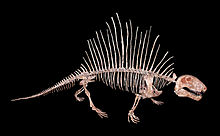Sphenacodontidae (Greek: "wedge point tooth family") is an extinct family of sphenacodontoid synapsids. Small to large, advanced, carnivorous, Late Pennsylvanian to middle Permian "pelycosaurs". The most recent one, Dimetrodon angelensis, is from the latest Kungurian or, more likely, early Roadian San Angelo Formation.[1][2] However, given the notorious incompleteness of the fossil record, a recent study concluded that the Sphenacodontidae may have become extinct as recently as the early Capitanian.[3] Primitive forms were generally small (60 cm to 1 meter), but during the later part of the early Permian these animals grew progressively larger (up to 3 meters or more), to become the top predators of terrestrial environments.[4] Sphenacodontid fossils are so far known only from North America and Europe.
| Sphenacodontidae Temporal range: Pennsylvanian - Guadalupian,
| |
|---|---|

| |
| Dimetrodon limbatus skeleton | |
| Scientific classification | |
| Domain: | Eukaryota |
| Kingdom: | Animalia |
| Phylum: | Chordata |
| Clade: | Synapsida |
| Clade: | Sphenacodontoidea |
| Family: | †Sphenacodontidae Marsh, 1878 |
| Genera & clades | |
Characteristics
editThe skull is long, deep and narrow, an adaptation for strong jaw muscles. The front teeth are large and dagger-like, whereas the teeth in the sides and rear of the jaw are much smaller (hence the name of the well-known genus Dimetrodon – "two-measure tooth", although all members of the family have this attribute).
Several large (~3 meters) and advanced members of this group (Ctenospondylus, Sphenacodon, Secodontosaurus and Dimetrodon) are distinguished by a tall sail along the back, made up of elongated vertebral neural spines, which in life must have been covered with skin and blood vessels, and presumably functioned as a thermoregulatory device. However, possession of a sail does not appear to have been essential for these animals. For example, there is the case in which one genus (Sphenacodon – fossils known from New Mexico) lacks a sail, while a very similar and closely related genus (Dimetrodon – fossils known from Texas) has one. During the Permian, these two regions were separated by a narrow sea-way, but it is not clear why one geographically isolated group should evolve a sail, but the other group not.
Classification
editThe family Sphenacodontidae is actually paraphyletic as originally described, defined by shared primitive synapsid characters;[citation needed] these animals constitute an evolutionary gradation from primitive synapsid to early therapsid. The clade Sphenacodontia is used to designate the monophyletic group that includes sphenacodontids and all their descendants (including mammals), while Sphenacodontidae in the strict sense includes only specialised pelycosaurs, and not earlier more primitive members of the family like Haptodus, Palaeohatteria, Pantelosaurus, and Cutleria (in pre-cladistic classifications all included under the genus Haptodus). The clade Sphenacodontoidea is used by Laurin and Reisz 1997 to designate the most recent common ancestor of Sphenacodontidae and Therapsida and all their descendants, and is defined by certain features of the skull.
Sphenacodontidae in a cladogram after Fröbisch et al., 2011:[4]
See also
editReferences
edit- ^ Olson, Everett C. (1962). "Late Permian terrestrial vertebrates, U.S.A. and U.S.S.R." Transactions of the American Philosophical Society. New Series. 52 (2): 1–224. doi:10.2307/1005904. JSTOR 1005904.
- ^ Laurin, Michel; Hook, Robert W. (2022). "The age of North America's youngest Paleozoic continental vertebrates: a review of data from the Middle Permian Pease River (Texas) and El Reno (Oklahoma) Groups". BSGF - Earth Sciences Bulletin. 193: 10. doi:10.1051/bsgf/2022007.
- ^ Didier, Gilles; Laurin, Michel (2021). "Distributions of extinction times from fossil ages and tree topologies: the example of some mid-Permian synapsid extinctions". PeerJ. 9 (e12577): e12577. doi:10.7717/peerj.12577. PMC 8667717. PMID 34966586.
- ^ a b Jörg Fröbisch; Rainer R. Schoch; Johannes Müller; Thomas Schindler; Dieter Schweiss (2011). "A new basal sphenacodontid synapsid from the Late Carboniferous of the Saar-Nahe Basin, Germany". Acta Palaeontologica Polonica. 56 (1): 113–120. doi:10.4202/app.2010.0039.
Further reading
edit- Carroll, R. L. (1988), Vertebrate Paleontology and Evolution, WH Freeman & Co.
- Colbert, E. H., (1969), Evolution of the Vertebrates, John Wiley & Sons Inc (2nd ed.)
- Laurin, M. and Reisz, R. R., 1997, Autapomorphies of the main clades of synapsids
- Reisz, R. R., 1986, Handbuch der Paläoherpetologie – Encyclopedia of Paleoherpetology, Part 17A Pelycosauria Verlag Dr. Friedrich Pfeil, ISBN 3-89937-032-5
- Romer, A. S., (1947, revised ed. 1966) Vertebrate Paleontology, University of Chicago Press, Chicago
- Romer, A. S. and Price, L. I., (1940), Review of the Pelycosauria, Geological Society of America Special Papers, No 28